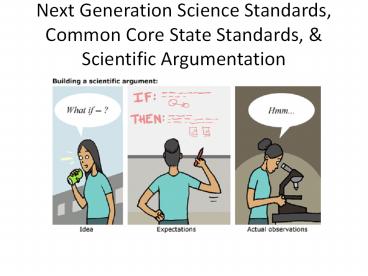Next Generation Science Standards, Common Core State Standards, - PowerPoint PPT Presentation
1 / 15
Title:
Next Generation Science Standards, Common Core State Standards,
Description:
Next Generation Science Standards, Common Core State Standards, & Scientific Argumentation Development of New Science Standards: Step 1: Development of Framework for ... – PowerPoint PPT presentation
Number of Views:208
Avg rating:3.0/5.0
Title: Next Generation Science Standards, Common Core State Standards,
1
Next Generation Science Standards, Common Core
State Standards, Scientific Argumentation
2
Development of New Science Standards
Step 1 Development of Framework for K-12 Science
Education
National Academy of Sciences
National Research Council
Released Final Framework (July 2011)
(Committee of 18 members)
- Practicing Scientists
- Science Education Researchers
- Science Education Standards and Policy Experts
3
Development of New Science Standards
Step 2 Development of Next Generation Science
Standards
- Managed by Achieve (Education reform Non-Profit
Organization) - 26 States (including NY) will lead development of
the new standards - from the Framework.
- 3) Final Standards are expected to be released by
the end of 2012.
4
Science Framework has 3 Dimensions
Dimension 1 Scientific Practices
- Asking questions and defining problems
- Developing and using models
- Planning and carrying out investigations
- Analyzing and interpreting data
- Using mathematics and computational thinking
- Constructing explanations and designing solutions
- Engaging in argument from evidence
- Obtaining, evaluating, and communicating
information
5
Science Framework has 3 Dimensions
Dimension 2 Crosscutting Concepts
- Have applications across all domains of science
- Patterns
- Cause and Effect
- Scale, Proportion, and Quantity
- Systems and System Models
- Energy and Matter
- Structure and Function
- Stability and Change
6
Science Framework has 3 Dimensions
Dimension 3 Disciplinary Core Ideas (Content)
- Domain Physical Science
- Matter And Its Interactions
- Motion And Stability Forces and Interactions
- Energy
- Waves And Their Applications in Technology For
Information - Transfer
Core Ideas
7
Science Framework has 3 Dimensions
Dimension 3 Disciplinary Core Ideas (Content)
- Domain Life Sciences
- From Molecules To Organisms Structures And
Processes - Ecosystems Interactions, Energy, And Dynamics
- Heredity Inheritance And Variations Of Traits
- Biological Evolution Unity And Diversity
Core Ideas
8
Science Framework has 3 Dimensions
Dimension 3 Disciplinary Core Ideas (Content)
- Domain Earth And Space Sciences
- Earths Place In The Universe
- Earths Systems
- Earth And Human Activity
Core Ideas
9
Science Framework has 3 Dimensions
Dimension 3 Disciplinary Core Ideas (Content)
- Domain Engineering, Technology, And Applications
of Science - Engineering Design
- Links Among Engineering, Technology, Science, And
Society
Core Ideas
10
Focus On Dimension 1 (Practices)
- Engaging In Argument From Evidence
- Obtaining, Evaluating, And Communicating
Information
These Scientific Practices are not only
emphasized in the Science Framework, but are
also emphasized in the Common Core State
Standards.
11
Common Core State StandardsELA
- College And Career Readiness Anchor Standards For
Reading - Read closely to determine what the text says
explicitly and to make logical - inferences cite specific textual evidence
when writing or speaking to support - conclusions drawn from the text.
- College And Career Readiness Anchor Standards For
Writing - Write arguments to support claims in an
analysis of substantive topics or - texts, using valid reasoning and relevant and
sufficient evidence.
- College And Career Readiness Anchor Standards
For Speaking And Listening - Present information, findings, and supporting
evidence such that listeners - can follow the line of reasoning and the
organization, development, and - style are appropriate to task, purpose, and
audience.
12
How Can We Integrate These Ideas Into Our
Classrooms?
13
Data vs. Evidence
Data Evidence
The size of each seed The mass of the seed The type of seed. The type of paper towel. The number of seeds that germinated. The number of seeds that germinated.
Data
Evidence
Data are the information and measurements from an
investigation. Evidence is a particular subset
of data an investigator uses to support or refute
a claim.
14
Claims and Evidence
Reasoning
Claims
Evidence
- A claim is an assertion or conclusion that
attempts to answer the original - question.
- The claim needs to be supported by evidence.
A statement without evidence - is only an opinion!
- The claim can then be defended via oral
presentations or written arguments.
15
Concluding Remarks
- Not only is it important for teachers to provide
students opportunities to conduct - scientific investigations, but teachers must
also provide students opportunities to - defend/argue their conclusions/claims by
utilizing evidence from the experiment.
- Educators should modify their existing inquiry
labs into a format that allows - students to develop precise claims supported by
evidence and defend their - claims in oral or written arguments to their
peers.































